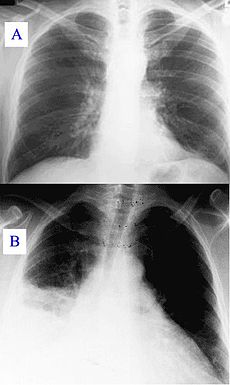- Pulmonary consolidation
-
Pulmonary consolidation Classification and external resources 
Pneumonia as seen on chest x-ray. A: Normal chest x-ray. B: Abnormal chest x-ray with consolidation from pneumonia in the right lung, middle or inferior lobe (white area, left side of image).DiseasesDB 10949 Consolidation is a clinical term for solidification into a firm, dense mass. It is more specifically used in reference to a region of lung tissue that, normally compressible, has filled with liquid,[1] a condition marked by induration[2] (swelling or hardening of normally soft tissue) of a normally aerated lung. Consolidation occurs through accumulation of inflammatory cellular exudate in the alveoli and adjoining ducts. Simply, it is defined as alveolar space that contains liquid instead of gas. The fluid can be pulmonary edema, inflammatory exudate, pus, inhaled water, or blood (from bronchial tree or haemorrhage from a pulmonary artery). It is clinically important in pneumonia: the signs of lobar pneumonia are characteristic and clinically referred to as consolidation.[3]
Signs
Signs that consolidation may have occurred include:
- Expansion of the thorax on inspiration is reduced on the affected side
- Vocal fremitus is increased on the side with consolidation
- Percussion is dull in affected area
- Breath sounds are bronchial
- Possible medium, late, or pan-inspiratory crackles
- Vocal resonance is increased. Vocal resonance testing can be done with a stethoscope. Here, the patient's voice (or whisper, as in whispered pectoriloquy) can be heard more clearly when there is consolidation, as opposed to in the healthy lung where speech sounds muffled.
- A pleural rub may be present[4]
Radiology
- Typically, an area of white lung is seen on a standard X-ray. [1] Consolidated tissue is radio-opaque, so that it is clearly demonstrable in X-rays and CT (computerized tomography) scans. Consolidation is often a middle-to-late stage feature/complication in pulmonary infections.
References
- ^ "Consolidation - Definition". Merriam-Webster. http://www2.merriam-webster.com/cgi-bin/mwmednlm?book=Medical&va=consolidation. Retrieved 2009-01-16.
- ^ "Induration- Definition". Merriam-Webster. http://www2.merriam-webster.com/cgi-bin/mwmednlm?book=Medical&va=induration. Retrieved 2009-01-16.
- ^ Metlay, JP, Kapoor, WN, Fine, MJ. Does this patient have community-acquired pneumonia? Diagnosing pneumonia by history and physical examination. JAMA 1997; 278:1440. doi:10.1001/jama.278.17.1440 PMID 9356004
- ^ Talley and O'Connor (2001). Clinical Examination, a Clinical Guide to Physical Diagnosis. Elsevier 4:121
Categories:- Medical terms
- Medicine stubs
Wikimedia Foundation. 2010.
